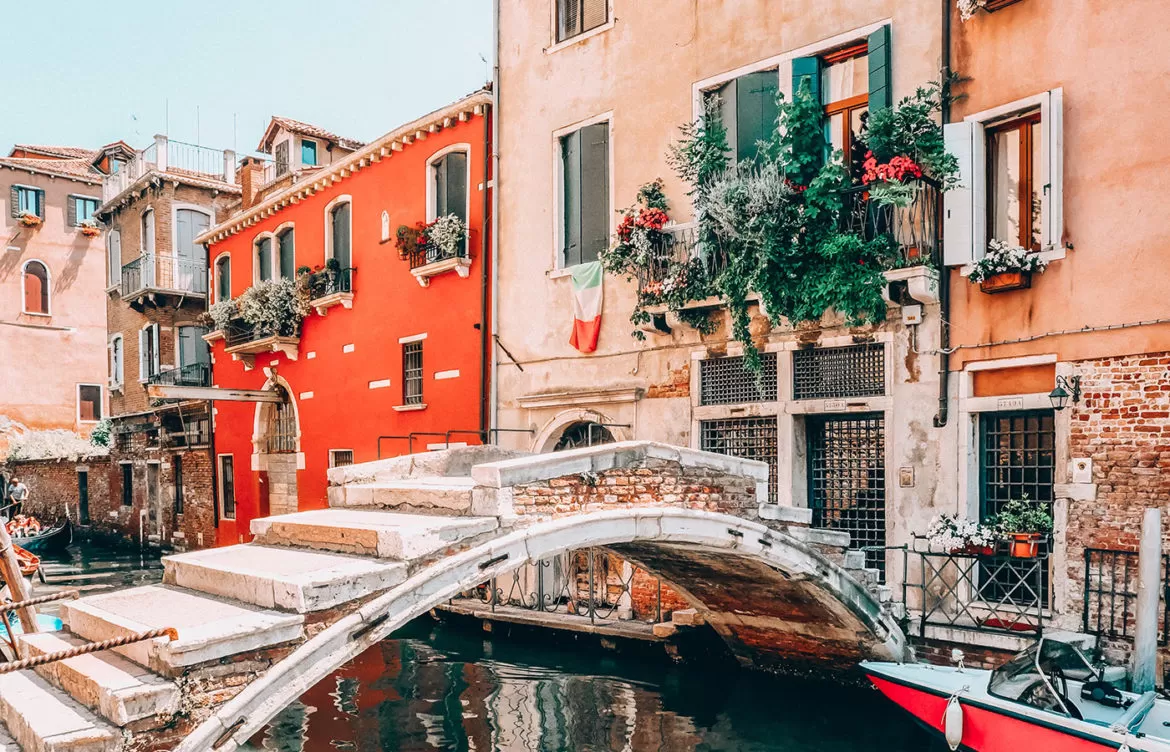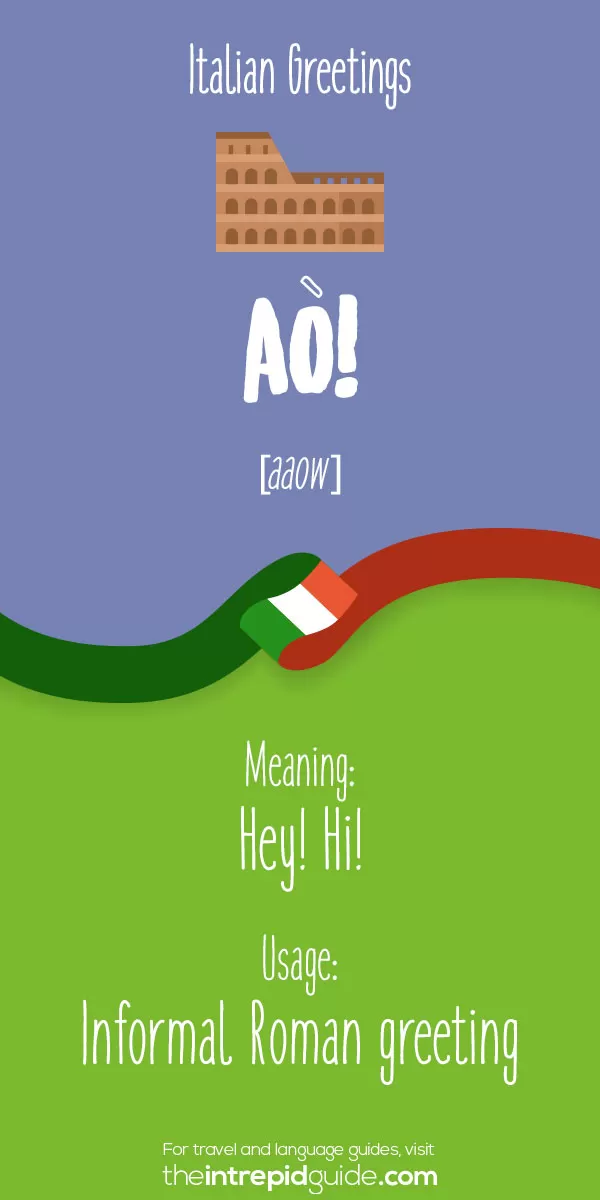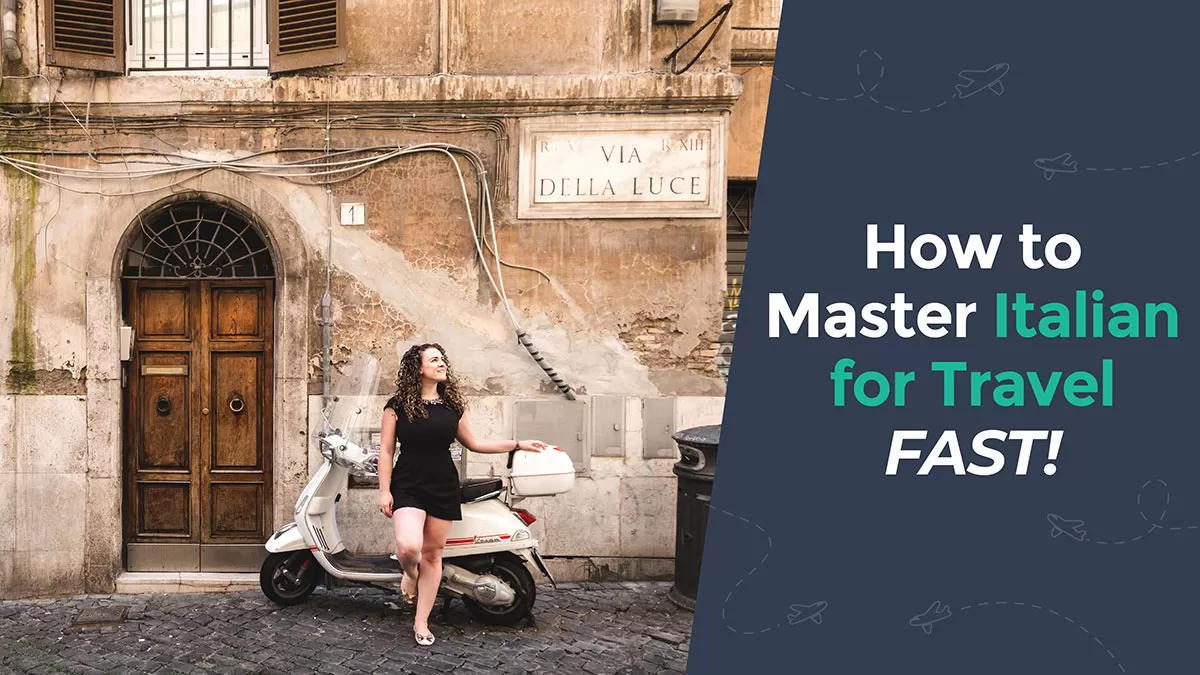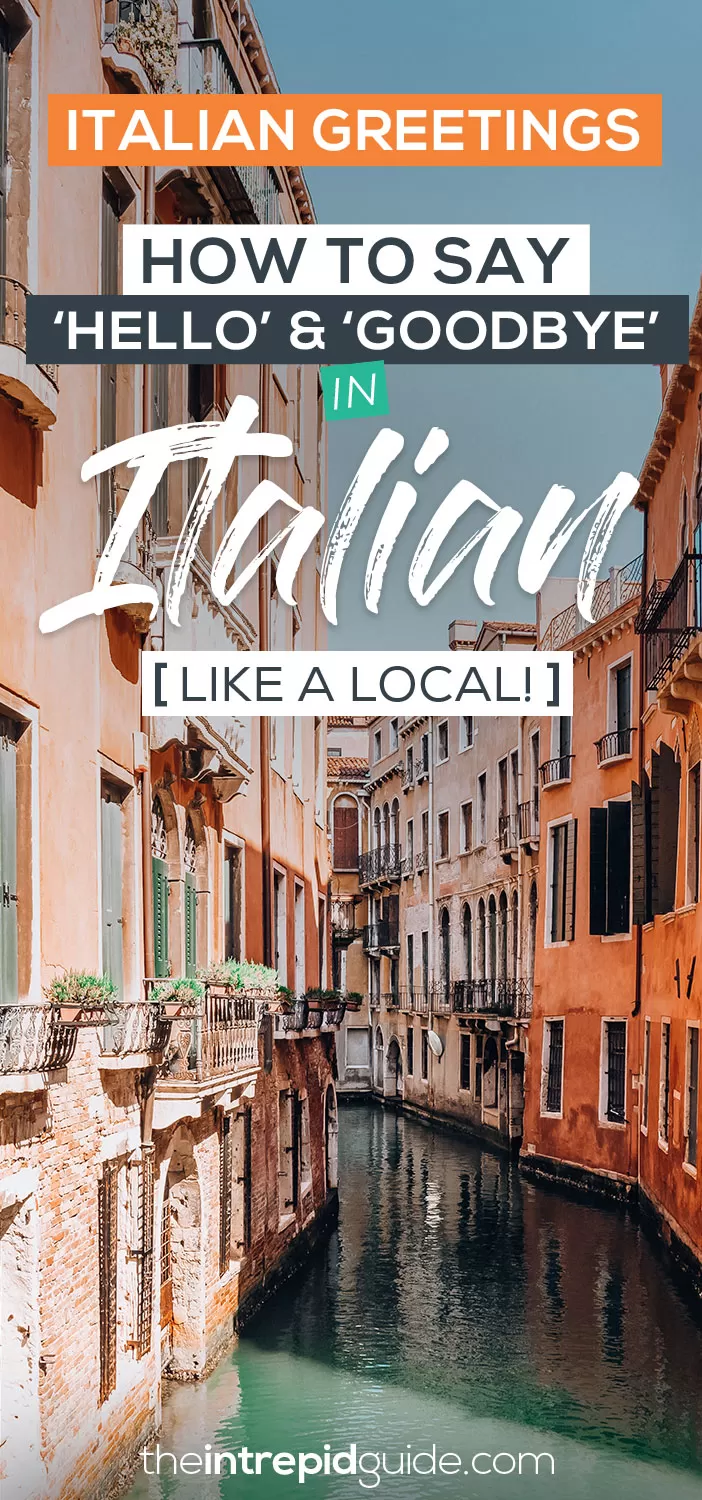It all starts by learning how to say ‘Hello’ in Italian. Break the ice and put a smile on locals faces with few common Italian greetings and you’ll be adopted into la famiglia (the family) in no time!
You know what they say, you never get a second chance to make a first impression. One guaranteed way to avoid being treated like a tourist and enjoy authentic travel experiences in Italy is by greeting locals in their native language. The best part? Italian greetings are super easy to learn too!
Knowing just a few of the most common words in Italian can make a huge difference. It’s respectful and shows that you’re making an effort to learn more about the people who speak the language, their beautiful country and culture.
When locals hear foreigners greet them in their language, they instantly become warmer and friendlier towards you. Italians are some of the most generous, kindest, and most talkative people in the world. They literally make you feel like one of the family. Imagine how wonderful your travels in Italy would be if you did as little as just greeted Italians in Italian and asked them how they are doing!
During one trip to Sicily, me and my four international girlfriends went out to dinner the first night. Shortly after we arrived at the restaurant, the lady at the table next to use took an interest in us and started talking to us. Maria was so impressed that we could all speak Italian, that she invited all us over to her home the next day for afternoon tea! This was the result of a brief five minute conversation! It just goes to show that a little can go a long way. Anything is possible! Read all about how mastering Italian changed my travel experiences and how it can help you do the same!
Can you handle the warmth and friendliness headed your way? If so, read on! Here are some of the most common Italian greetings, as well as useful expressions you can use to ask Italian how they are doing.
Cominciamo! (Let’s get started!)
Looking for something specific? Use these links to jump around.
Table of Contents
Don’t miss my guide on 16 ways to say goodbye in Italian and 5 ways to ask ‘How are you?’ in Italian.
Formal and Informal: How to be Polite in Italian
In Italian, it’s important to know that there is a formal and an informal way to address another person. Unlike in English, our version of being formal and informal is the difference between not swearing or just using more sophisticated words.
Italian has an informal tense which is used when speaking with good friends, young people, children, and your family members. Basically, anyone you know well.
However, when speaking to a person you don’t know well such as a superior, shopkeeper, waiter, teacher, professor, or someone of important social standing such as a doctor, or police officer, then you should address him or her in the formal tense.
When you become more familiar with someone, you may change from using the formal tense to the informal tense. According to custom, the elder person initiates this change. It’s handy to learn both tenses even if you don’t use the informal very much. Whenever in doubt, the safe option is to use the formal tense.
Italian Greetings: 10 Common Ways Italians Say ‘Hello’
1. How to say ‘Hi’ in Italian – Ciao!
How to pronounce it: chaow
Meaning: Hi, Bye
Usage: Informal Italian greeting
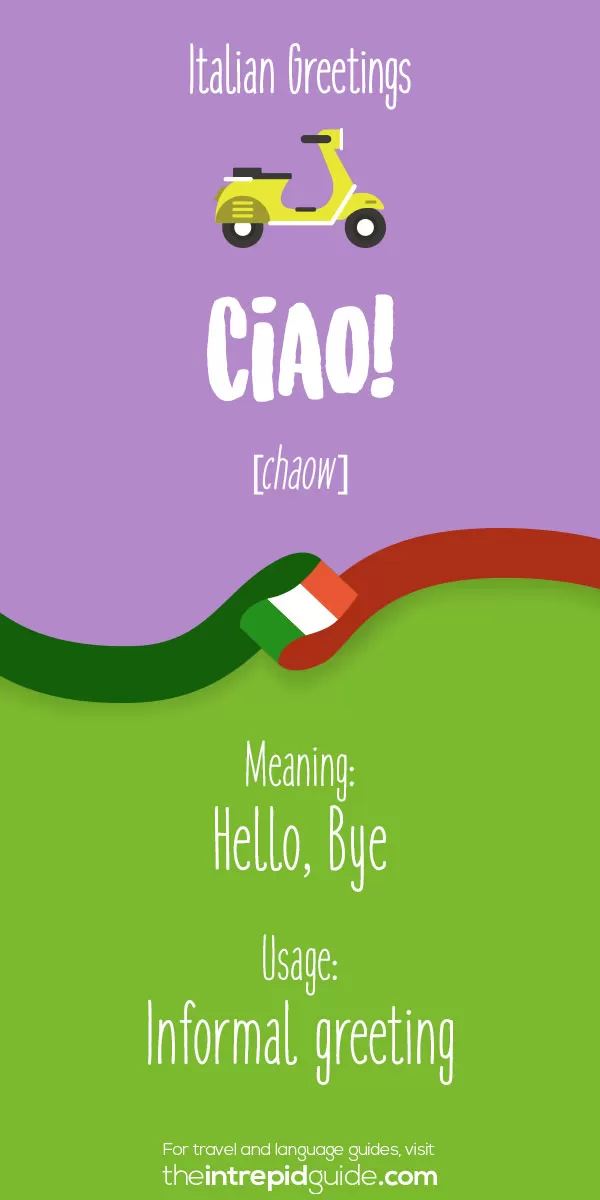
The origins of ‘ciao’ are rather interesting too with its roots in the Venetian dialect. The original phrase was ‘scia’o vostro’ which literally meant ‘I am your slave’. This phrase was typically used to say ‘I am there if you need me’. Similar to the English ‘at your service’, it was an expression or promise of goodwill among friends.
Nowadays, ‘ciao’ is one of the most popular greetings not only in Italy but in the whole world. Languages around the world have adopted ‘ciao’ as one of the ways to say hello and/or goodbye. In Germany, for example, it can be spelled ‘ciao’ or ‘tschau’, in French it’s ‘tchao’ in Czech it’s spelled ‘čau’, in Greek it’s ‘τσάο’ and in Spanish it’s ‘chau’. And that’s just to name a few!
However, if you don’t want to repeat the same word all the time or need something more formal, here’s a formal Italian greeting you can use.
Depending on how you say ‘ciao’ it can also take on a new meaning. For example, in Italian and Portuguese, when you say it twice, either ‘ciao ciao!’ or ‘tchau tchau!’ it means ‘goodbye’, but when you say it three or four times, it means “bye, I’m in a hurry!”.
When an Italian is super happy to see you, they will drag out the pronunciation of the ‘a’, which is them basically saying “Hi! I’m so happy/amazed to meet you!”
Want to be sarcastic? Italian’s might say something like ‘sì, ciao!’, meaning ‘Yeah, right!’.
For more common phrases, learn how to say goodbye in Italian with my guide.
2. How to say ‘Hello’ in Italian – Salve
How to pronounce it: sal-veh
Meaning: Hello, Bye
Usage: Informal and formal Italian greeting
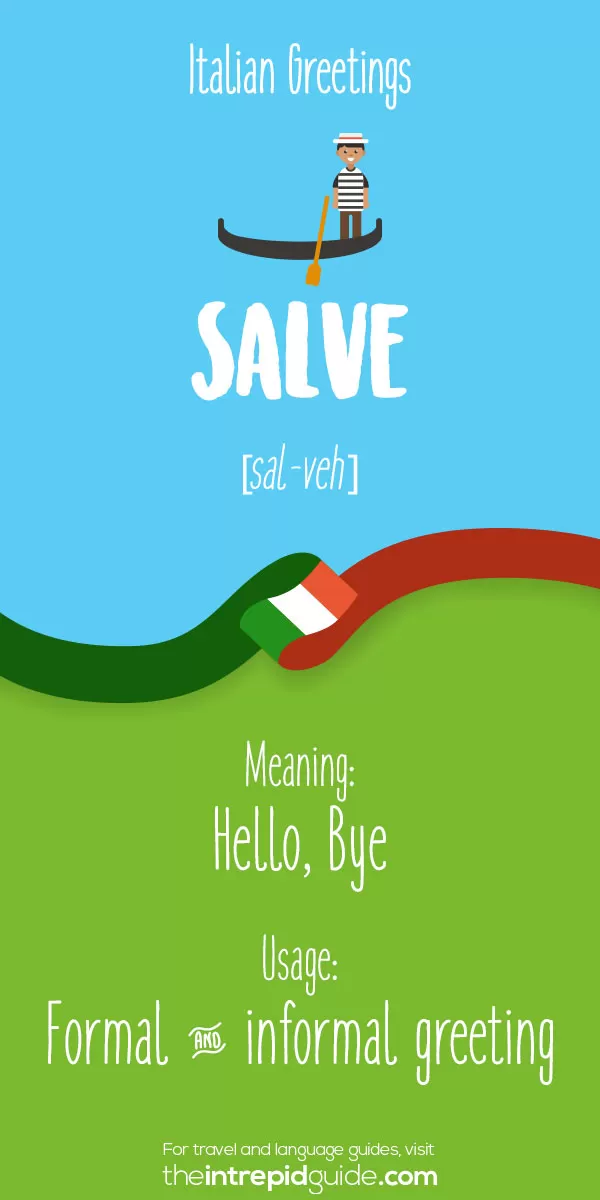
The word ‘salve’ comes from the Latin verb ‘salvere’, which means ‘to be well, in good health’, related to ‘salvus’, ‘health’. The English words ‘to salute’ and ‘salutations’ have similar roots.
You can use ‘salve’ if you want to ‘salute’ someone in a formal or informal situation at any time of the day.
3. How to say ‘How nice to see you’ in Italian – Che piacere (ri)vederti
How to pronounce it: keh pyah-chair-ray (ree)veh-der-tee
Meaning: How nice to see you (again)
Usage: Informal Italian greeting
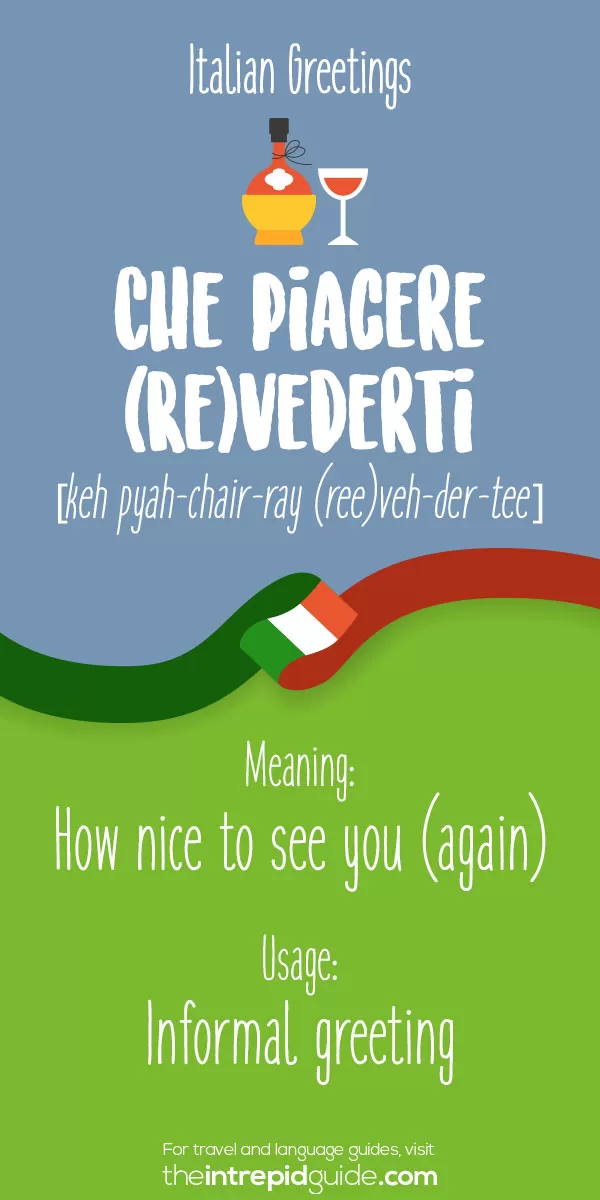
Use this greeting when you want to tell someone how happy you are to see them (vederti) or see them again (riverderti). Italians tend to use this expression when they haven’t seen someone in a while or with someone they see often but are genuinely happy to see them again.
4. How to say ‘Good Morning’ in Italian – Buongiorno
How to pronounce it: bwohn-jor-noh
Meaning: Good morning
Usage: Informal and formal greeting used before 3-4 p.m
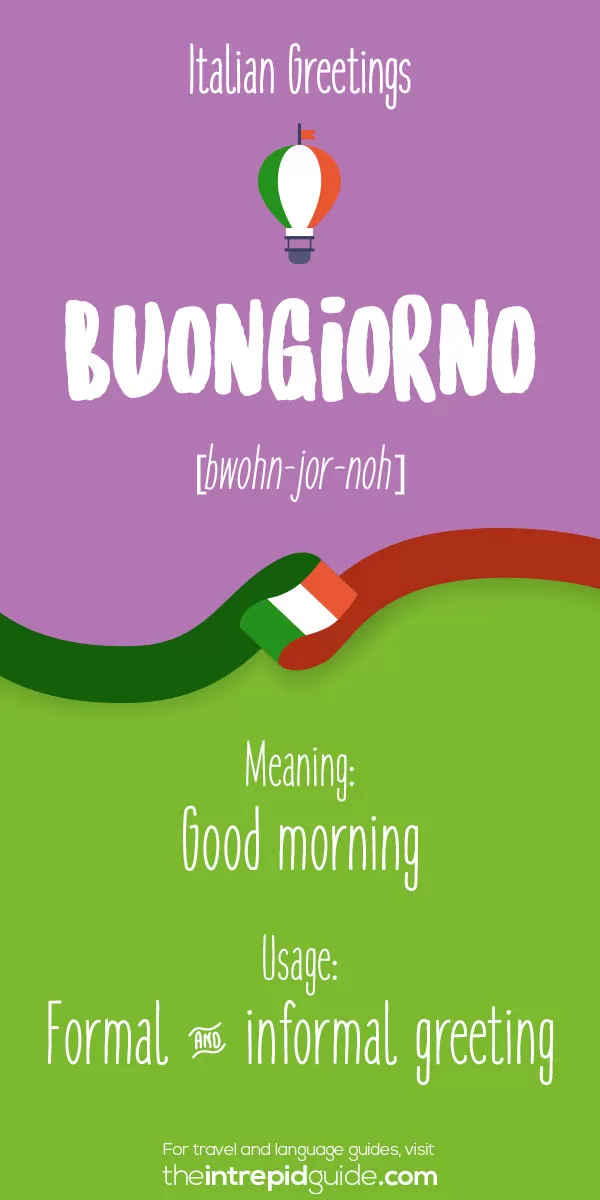
‘Buongiorno’ literally means ‘good day’ and it is used to say ‘good morning’ and ‘good afternoon’ in Italian. You can safely use it up until around 3-4 o’clock in the afternoon.
‘Buongiorno’ is a formal alternative to ‘ciao’ (but until 4 p.m.) and it is a good polite phrase to use whenever greeting a stranger or in a public place, like a shop or a cafe.
5. How to say ‘Good Afternoon / Good Evening’ in Italian – Buonasera
How to pronounce it: bwoh-nah-seh-rah
Meaning: Good afternoon/ Good evening
Usage: Informal and formal greeting used after 3-4 p.m
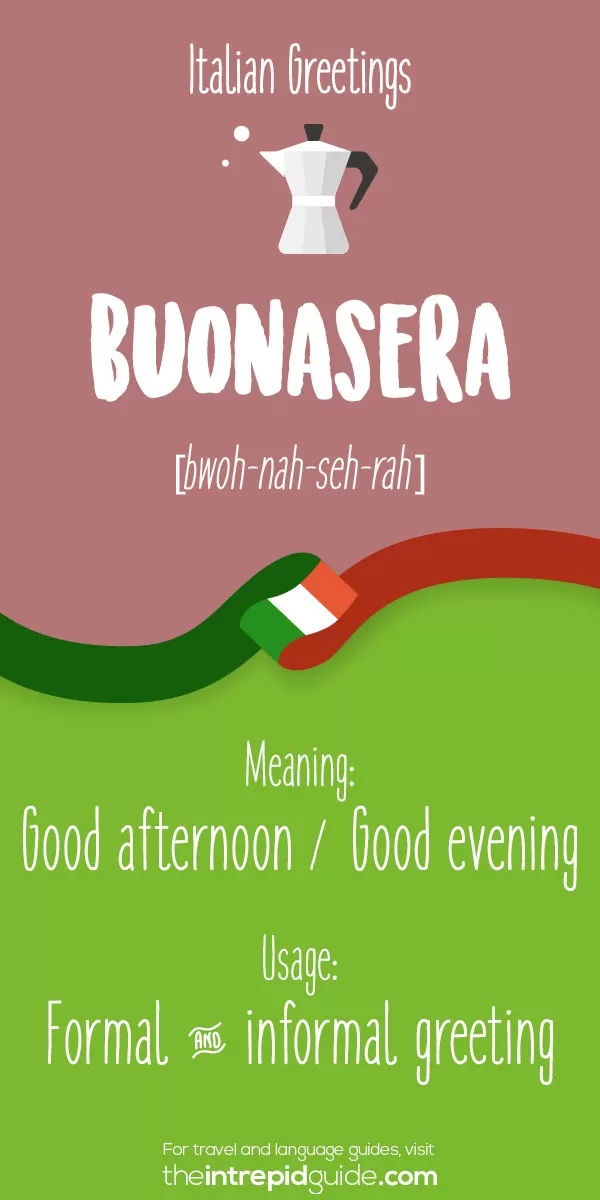
It is okay to say ‘buonasera’ up until as late as 10 p.m., in formal and informal situations. People use it with friends, but it is slightly more polite than ‘ciao’ and, like ‘buongiorno’, it is a polite phrase to use when you enter a shop or another public place where you’re likely to encounter people you don’t know..
When you are leaving and want to wish someone a good evening, you can say ‘buona serata’.
6. How to say ‘Hey’ in Roman – Aó!
How to pronounce it: aaow
Meaning: Hey! Hi! / Wow!
Usage: Informal Roman dialect greeting
When in Rome, do as the Romans do….use Roman greetings! If you want to sound Roman and impress your newfound Roman friends, then say ‘Aó!’. This is a very informal greeting and not really used anywhere else in Italy as it’s from the Roman dialect Romanesco. Get more cool Roman dialect words and expressions here.
This common Roman greeting is very common among friends and you’ll often hear them say something like ‘Aó! Ciao! Come te butta?’ meaning ‘Oh Hey! Hi, how’s it going?’. (Come te butta? literally means ‘How are you throwing yourself’. I just love the imagery! ‘Aó’ is also used as an exclamation to mean something ‘wow’ and is added either to the beginning or end of a sentence for emphasis.
Recommended: Top 10 unsual things to do in Rome that aren’t on your list
7. Say ‘Buon dì’ as an alternative to ‘Buongiorno’
How to pronounce it: bwohn dee
Meaning: Hello, Good morning
Usage: Informal and formal Italian greeting
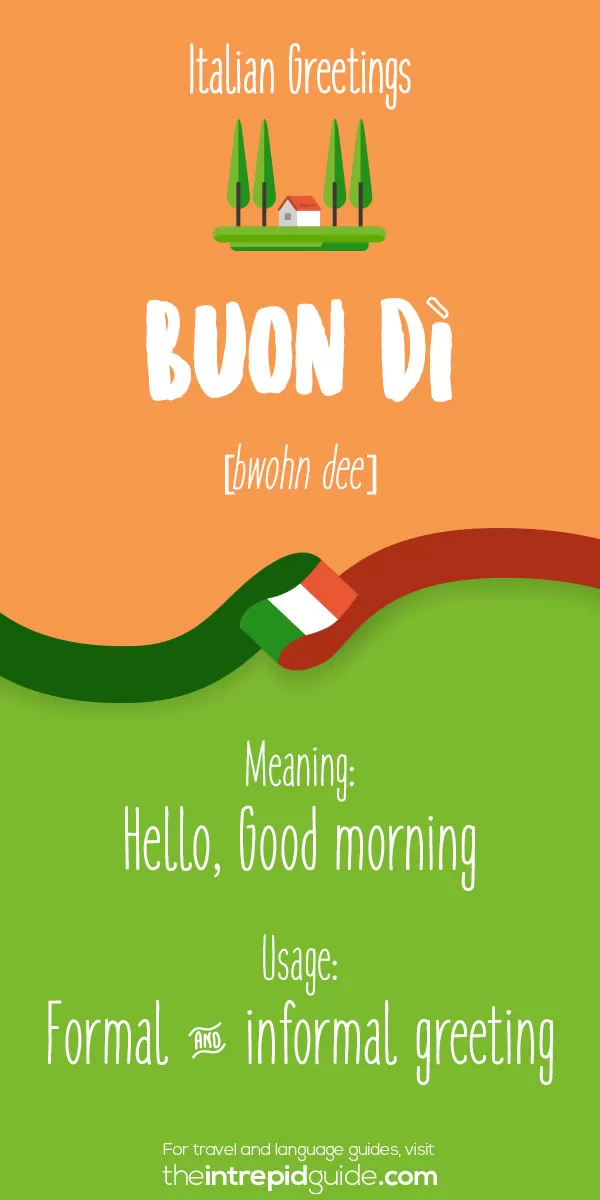
Buon dì greeting is less used than ‘buongiorno’ but will add variety to your speech and impress your Italian friends. They will, naturally, be glad to just hear ‘ciao’ or ‘buongiorno’ from you, but ‘Buon dì, come va?’ (Good morning, how’s it going?) might win you a few more points.
8. How to say ‘Nice to meet you’ in informal Italian – Piacere di conoscerti
How to pronounce it: pyah-chair-ray dee koh-noh-sher-tee
Meaning: Nice to meet you
Usage: Informal Italian greeting
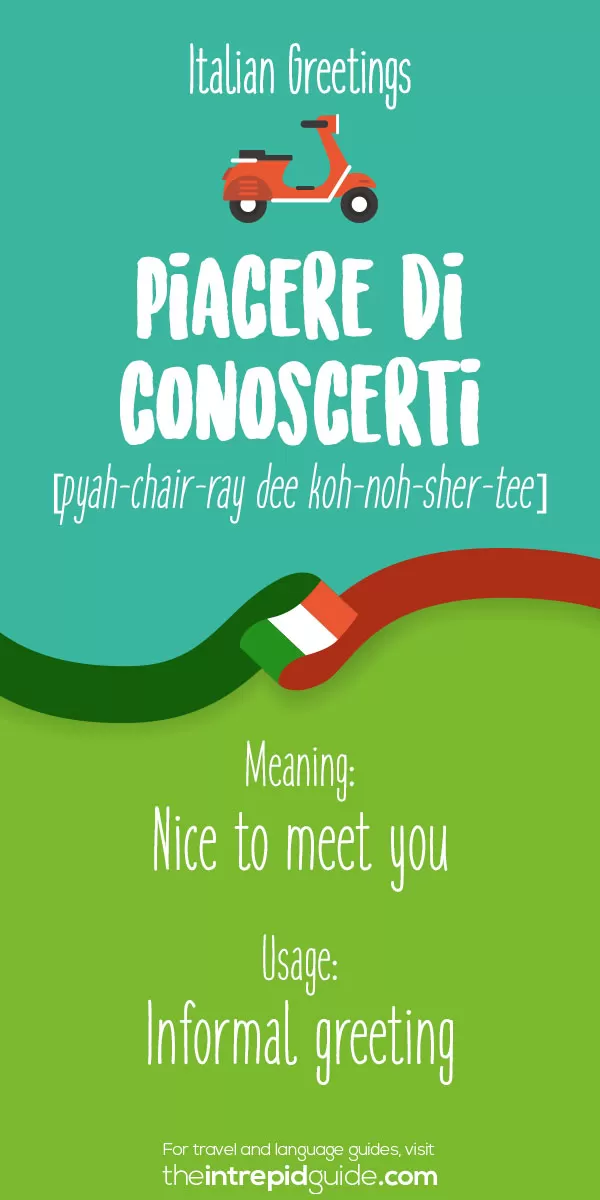
9. How to say ‘Nice to meet you’ in formal Italian – Piacere di conoscerLa
How to pronounce it: pyah-chair-ray dee koh-noh-sher-lah
Meaning: Nice to meet you
Usage: Formal Italian greeting
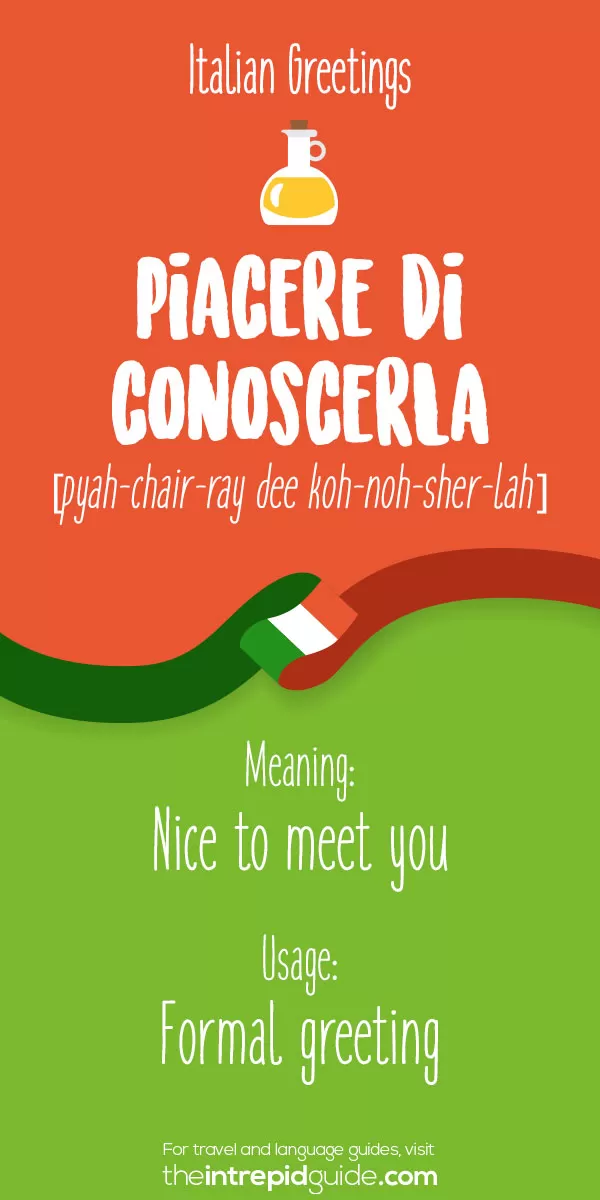
10. How to say ‘Hello’ on the phone in Italian – Pronto!
How to pronounce it: pron-toh
Meaning: Hello! (lit. ready)
Usage: Neutral Italian greeting
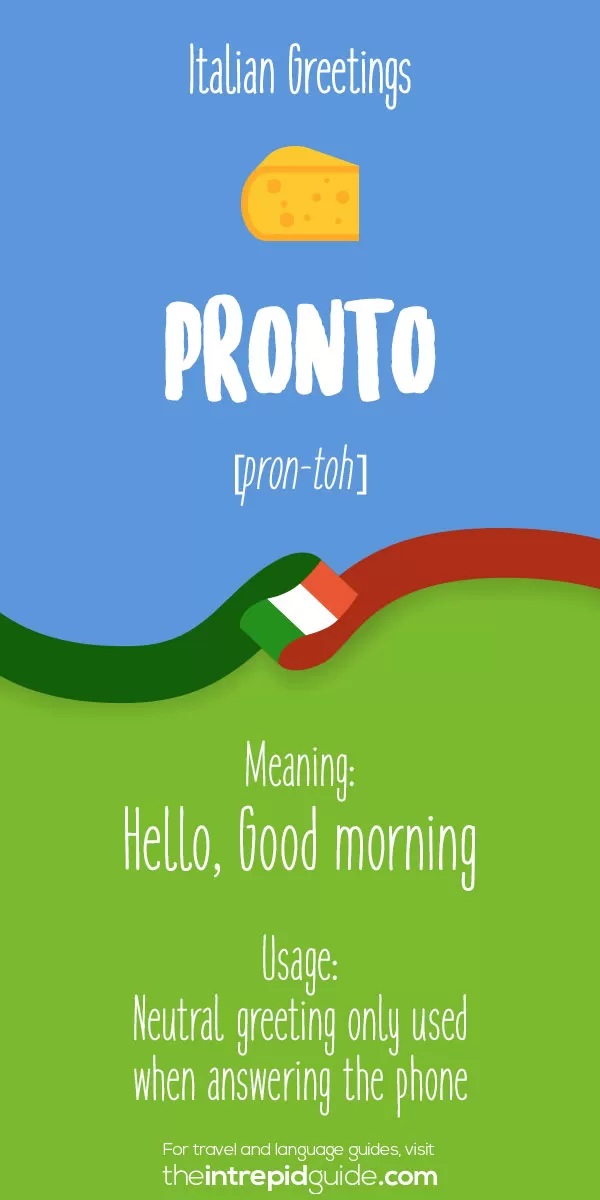
Next time, when your Italian teacher or your friends from Italy call you, greet them with a ‘Pronto!’ – they will be glad to hear it!
Tips for using Italian Greetings
When greeting someone, Italians often use a combination of all the greetings shown above. For example, in Rome you might hear: ‘Aó! Ciao! Come stai!’, or ‘Salve, Buongiorno!’, or ‘Salve! Che piacere vederti!’. Keep the conversation going and leanr how too say how are you in Italian.
C’è la puoi fare! (You’ve got this!)
That’s it! You’ve just learned the most common Italian greetings. There is a lot to choose from and may seem overwhelming at first, but as you put them into practice hear them being used, you’ll realise they are easier to learn than you think.
Quite often you can use the same phrases to both greet and say goodbye in Italian. So, if at first you struggle to remember which greetings are formal or informal, just remember one or two: ‘buongiorno’ (Good morning) and ‘arrivederci‘ (Goodbye).
The important thing is to stay motivated and have a positive attitude. Learning Italian greeting are a great way to get your foot in the door and break the ice with locals, even if your fumble and make mistakes. Any effort you make will always be appreciated. If you accidentally slip and say ‘ciao!’, Italians are very forgiving people and can see that you’re still learning.
As the saying goes, well begun is half done. Learning Italian greetings is a great start to mastering the Italian language for travel and making a good first impression on your future new Italian friends.
Learn Italian FAST! Enrol in my popular Italian course here.
Learn Italian with me, The Intrepid Guide!
Travelling to Italy? Don’t be treated like a tourist! Live your best travel experiences and learn Italian for less than the cost of eating at a tourist trap restaurant or a taxi driver who has “taken you for a ride”. In addition to my free Italian travel phrase guides, I’ve made it even easier for you to master the Italian language so you can create lifelong memories as you mingle with locals, get local tips, avoid tourist traps, and make new friends. Who knows you, you maybe even be invited over for afternoon tea by a lovely Sicilian family, like I was! Read all about how speaking Italian changed my life and check out The Intrepid Guide Languages courses here.
Here’s what my students are saying:
I really enjoyed the Master Italian for Travel FAST course, it certainly exceeded my expectations. The learning methodology is great, and easy to follow and found that I progressed much faster in the last 4 weeks than I ever did on my own or using other language apps. Grazie mille Michele, I can’t wait until I can put my new skills into action! – Roma Small
Click here for instant access!
Learning Italian? Check out these Italian language guides
- How to Conjugate Italian Verbs in 3 Simple Steps [Italian for Beginners]
- TOP 100 Most Common Italian Words (Plus PDF Cheat-Sheet & Quiz)
- 10 Ways Natives REALLY Say ‘You’re Welcome’ in Italian
- 125 Most Common Italian Phrases for Travel You’ll Ever Need [PLUS Printable]
- Is Italian Hard to Learn? 7 Common Mistakes & How to Avoid Them
- Master Days of the Week in Italian (7 Simple Memory Hacks)
- Italian Numbers: How to Count in Italian From 0 to 1 Billion (Plus PDF Download)
- How to Order Food & Drinks in Italian [Italian for Beginners]
- 15 Italian Words You Should NEVER Mispronounce [& How Not To]
- 11 Effective Hacks That’ll Help You Learn Italian So Much Faster
- Top 14 Italian Words You Should NEVER Say [& What to Use Instead]
- 20 Hilarious Everyday Italian Expressions You Should Use
- Romanesco: 25 Cool Roman Dialect Words You Should Use in Rome
- 10 Reasons Why Learning Italian Will Change Your Life
- 10 Italian Expressions Italians Love Saying
- Italian for Beginners | 8 DEADLY Mistakes in Italian (& How to Avoid Them)
- 10 Italian Phrases That Will Instantly Make You Sound more Italian
- Funny Italian Sayings: 26 Food-Related Insults You Won’t Forget
- 15 Romantic Italian Films That’ll Make You Love Italy Even More
- How to Master Common Italian Phrases for Travel (Like a Local!)
Want to know more about learning languages? Start here!
- 22 Top Language Learning Resources You Should Use
- 10 Proven Memory Hacks: How to Remember New Vocabulary Faster
- How long does it REALLY take to learn a language? [A Practical Guide]
- 10 Proven Memory Hacks: How to Remember New Vocabulary Faster
- 18 Unexpected Advantages & Health Benefits of Learning A Foreign Language
- 23 Cool Gift for Language Learners They Will Actually Use and Love
- Memrise vs Duolingo: Which Language App is Best For You?
- Mondly Review: 10 Ways Mondly Drastically Improved My Language Learning
- 203 Most Beautiful Untranslatable Words [The Ultimate List: A-Z]
- 6 Language Learning Tips: How to Learn a Language from Home
- What Type of Language Learner Are You? Your 4-Step Personalised Learning Plan
- 44 Best Movies on Disney Plus for Learning Languages
- 13 Ways to Seamlessly Integrate Language Learning into Your Daily Life
- 10 Pro Tips: How to Learn a Language with a Full-Time Job
- 7 Reasons Why You Should Go on a Language Holiday
- Essential Travel Phrases: How to be Travel Fluent in 10 Simple Steps
- How to Learn Your First Foreign Language in 8 Simple Steps: A Beginner’s Guide
- 11 Life-Changing Reasons Why You Should Learn a Language
- 42 beautiful Inspirational Quotes for Language Learners
- Language learning tips: 11 Polyglots Reveal The Secrets of Their Success
- Top 10 Best Ways to Learn a Language Better and Faster
- How Many Languages are there in the World?
- 78 FREE Dictionaries to Learn a Language Fast [Free eBook Download]
- 22 KEY Travel Phrases That Will Transform Your Travels [Free Guide]
Like it? Pin it for later!
Over to you!
Do you have a question these Italian greetings or learning Italian? Ask me below!
Let me know using the comments section below or join me on social media to start a conversation.
Thanks for reading and I hope you enjoyed this post.
Like what you see? Subscribe using the form below to have all of my posts delivered directly to your email.

